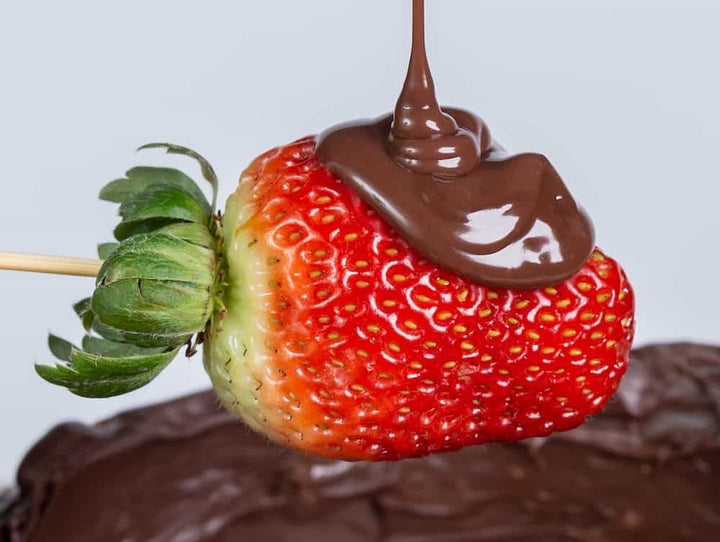How about this for a tantalising thought: a piece of chocolate not only as a delightful treat, but as a source of dietary fibre?
It's a concept that might seem somewhat unexpected, but it's also one that's grounded in truth.
In this article, we'll peel back the glossy wrappers and delve into the world of fibre in chocolate, exploring how this indulgence could contribute to your fibre intake.
Is There Fibre In Chocolate?
Yes, there is indeed fibre in chocolate.
It may come as a surprise to some, given that chocolate is often thought of purely as a sweet treat, but cocoa beans, from which chocolate is made, contain significant amounts of dietary fibre.
However, the amount of fibre can vary quite a lot depending on the type of chocolate.
Dark chocolate, particularly varieties with a high percentage of cocoa, tends to have more fibre.
This is because the fibre in chocolate comes from the cocoa solids, so the more cocoa solids a bar of chocolate contains, the more fibre it will have.
For instance, a 100g bar of dark chocolate with 70-85% cocoa can contain up to 10g of fibre, which is a substantial contribution to the recommended daily fibre intake.
Milk chocolate contains less cocoa solids than dark chocolate, so it has less fibre.
White chocolate contains no cocoa solids at all, only cocoa butter, so it doesn't contain any fibre.
Remember, whilst it's good to know that there is a nutritious aspect to chocolate, it's still a high-energy food with a significant sugar content, so it should be enjoyed in moderation as part of a balanced diet.
Related Post: Chocolate Refining Process.
Is Chocolate High In Fibre?
Whether chocolate can be considered high in fibre depends greatly on the type of chocolate.
Dark chocolate, especially the varieties that contain a high percentage of cocoa solids (70% or more), is relatively high in fibre.
For example, a 100g bar of dark chocolate with 70-85% cocoa might contain up to 10g of fibre, which is around a third of the recommended daily intake for adults in the UK.
Milk chocolate, on the other hand, typically contains less fibre because it has a lower proportion of cocoa solids.
The same 100g portion of milk chocolate would usually provide around 2g of fibre, considerably less than dark chocolate.
White chocolate, which contains no cocoa solids at all and is made instead from cocoa butter, sugar, and milk solids, has virtually no fibre.
While the fibre content of dark chocolate is noteworthy, it's important to remember that chocolate also contains high levels of sugar and saturated fat, and is energy-dense (that is, high in calories).
Therefore, while it can contribute to your fibre intake, it should be enjoyed in moderation as part of a balanced diet.
Related Post: How Does Chocolate Raise Blood Sugar?
What Type of Chocolate Has the Most Fibre?
The type of chocolate that has the most fibre is dark chocolate, specifically the varieties with a high percentage of cocoa solids.
Fibre in chocolate comes from the cocoa solids - the remaining part of the cacao bean after the cocoa butter has been removed.
Therefore, the higher the percentage of cocoa solids, the higher the fibre content will be.
A high-quality dark chocolate with 70% to 85% cocoa solids can provide a significant amount of fibre. In a 100g bar of this type of chocolate, you might find up to 10g of fibre.
This is quite a substantial amount when you consider that the recommended daily fibre intake for adults in the UK is 30g.
On the other hand, milk chocolate and white chocolate have much lower levels of cocoa solids and thus contain less fibre.
In fact, white chocolate, which contains no cocoa solids at all, has virtually no fibre.
Remember, though, that while dark chocolate does contain a decent amount of fibre, it's also high in sugar and fat, so it should be enjoyed in moderation as part of a balanced diet.
Related Post: Is Chocolate a Carbohydrate?
Is Fibre Good for You?
Absolutely, fibre is indeed good for you.
It plays a crucial role in maintaining a healthy digestive system and has several other health benefits.
Dietary fibre, also known as roughage, is a type of carbohydrate that cannot be digested by our bodies.
Instead, it passes relatively intact through our stomach, small intestine, and colon and out of our bodies.
It might not sound appealing, but this process is vital for our health.
There are two types of dietary fibre – soluble and insoluble.
Both types have important roles to play in your health.
Soluble fibre, which dissolves in water to form a gel-like material, can help to reduce your blood cholesterol and glucose levels.
Insoluble fibre, on the other hand, can help food move through your digestive system, promoting regularity and helping to prevent constipation.
A fibre-rich diet can also aid weight management, as foods with high fibre content tend to be more filling, so you're less likely to overeat.
Furthermore, a diet high in fibre has been linked to a lower risk of developing heart disease, stroke, type 2 diabetes, and bowel cancer.
In the UK, it's recommended that adults aim to consume at least 30g of fibre a day.
This can come from a variety of sources, including wholegrains, fruits and vegetables, and even a square or two of dark chocolate!
So, in summary, fibre is definitely good for you and is a crucial component of a balanced diet.
Why Do Some People Have to Avoid Fibre?
While fibre is an essential part of a balanced diet, there are certain situations in which some people may need to avoid or limit their intake of it.
-
Digestive disorders: Some people with certain digestive disorders, such as Irritable Bowel Syndrome (IBS) or Inflammatory Bowel Disease (IBD), including Crohn's disease and ulcerative colitis, may need to limit their fibre intake, especially during flare-ups. This is because a high intake of certain types of fibre can lead to symptoms like bloating, gas, and abdominal pain.
-
Diverticular disease: This condition involves small pouches (diverticula) that form in the walls of the colon. If these pouches get inflamed or infected, a condition known as diverticulitis, a low-fibre or even no-fibre diet might be recommended, at least in the short term, to let the colon rest and heal.
-
Prior to medical procedures: Sometimes, a low-fibre diet is recommended before certain medical procedures, such as a colonoscopy, to ensure the bowel is clean.
-
Certain gastrointestinal surgeries: After certain types of surgery on the digestive tract, a low-fibre diet may be necessary to avoid causing irritation or blockages.
It's important to remember that these are specific situations, and anyone needing to avoid or limit fibre for these reasons should do so under the guidance of a healthcare professional.
For most people, a diet that is rich in fibre is beneficial and is recommended for promoting good digestive health.
Can You Eat Chocolate On A Low Fibre Diet?
Yes, you can generally eat chocolate on a low-fibre diet, but the type of chocolate matters.
Dark chocolate, which is high in fibre due to its higher cocoa solid content, may not be the best choice for a low-fibre diet.
On the other hand, milk chocolate and white chocolate, which contain lower amounts of cocoa solids, are usually lower in fibre and might be more suitable options for a low-fibre diet.
However, it's important to remember that while they're lower in fibre, milk chocolate and white chocolate are high in sugar and fat, so they should be eaten in moderation.
As always, if you have been advised by a healthcare professional to follow a low-fibre diet due to a specific medical condition, it's important to discuss any dietary questions or concerns with them.
They can provide personalised advice tailored to your individual nutritional needs and health circumstances.
Where Can You Buy High-Quality Chocolate?
If you're in the market for high-quality chocolate, look no further than us here at Whitakers Chocolates.
With over 135 years of experience in the art of chocolate making, we've spent generations perfecting our recipes and techniques, earning us a reputation for crafting exceptional chocolates.
At Whitakers, we're firm believers in quality, which is why we insist on using only the finest and most natural ingredients in our chocolates.
You won't find anything nasty or artificial here – our chocolates are 100% natural, free from any unwanted additives.
We believe that the best chocolates come from the best ingredients, which is why we take such care in selecting ours.
Over the years, we've grown our range significantly, always with an eye towards ensuring there's something for everyone.
We understand that dietary needs and preferences vary, which is why we've worked hard to develop a range that includes options for those living a vegetarian, vegan, or gluten-free lifestyle.
At Whitakers, we're firm believers that everyone should have access to great chocolates, regardless of their dietary requirements.
Whether you're after our classic dark, milk, or white chocolates, our famous chocolate wafer thins, or any of the other tempting treats in our range, you can be confident that you're getting a product that's been crafted with care and attention to detail.
We invite you to discover the difference that over a century of experience makes – try Whitakers Chocolates today.
Here are some treats that might tempt you!
- Dark chocolate bar infused with real sea salt and lime juice
- Dark chocolate peppermint fondant creams
- Couverture chocolate - Easymelt 55% dark chocolate mini shards - made for melting!
-
Milk chocolate wafer thins, with crunchy sugar crystals flavoured with natural sea salt and caramel
- The ultimate in luxury, our range of hand finished chocolate truffles
Some Notes From an Expert Chocolatier
As expert chocolatiers with over 135 years in the industry, we at Whitakers Chocolates have a deep understanding of all aspects of chocolate - including its nutritional profile.
One such aspect, perhaps surprisingly to some, is the presence of dietary fibre in chocolate.
The presence and amount of fibre in chocolate are largely determined by the cocoa content.
Dark chocolate, for instance, due to its high percentage of cocoa solids, is a good source of dietary fibre.
A bar of dark chocolate with a high cocoa content, say around 70-85%, can provide a significant amount of your daily fibre intake.
It's one of the many reasons we cherish the rich, deep flavour of dark chocolate; it's not just about the taste, but also about the benefits it offers.
Conversely, milk and white chocolate have lower cocoa solid content and thus contain less fibre.
They have their place in the chocolate world and are loved for their creamy, sweet taste but, from a dietary fibre perspective, dark chocolate holds the upper hand.
However, while dark chocolate does contain beneficial fibre and other nutrients, we must remember it also carries a higher caloric value due to the sugar and fat content.
Like everything, it should be consumed as part of a balanced diet.
Over the years, we've seen a growing interest in the health properties of chocolate, with more and more customers seeking out high-cocoa chocolate for its fibre content and other potential health benefits.
At Whitakers, we've responded to this by offering a range of dark chocolates with varying cocoa content, ensuring there is something for every taste and dietary requirement.
In the end, it's about finding a balance between the sensory pleasure of enjoying a piece of chocolate and the nutritional benefits it can provide.
As chocolatiers, we feel privileged to play a part in striking that balance.
Final Notes On Fibre In Chocolate
The fibre content in chocolate varies depending on the type of chocolate in question.
Dark chocolate, rich in cocoa solids, stands out as a source of dietary fibre, providing not just a sublime flavour experience but also some nutritional benefits.
While milk and white chocolate typically contain less fibre due to their lower cocoa content, each type of chocolate brings its own unique pleasures and serves different preferences and purposes.
Whether you're a fan of the robust intensity of dark chocolate, the creamy smoothness of milk chocolate, or the sweet delicacy of white chocolate, there's a place for all in the diverse world of chocolate.









